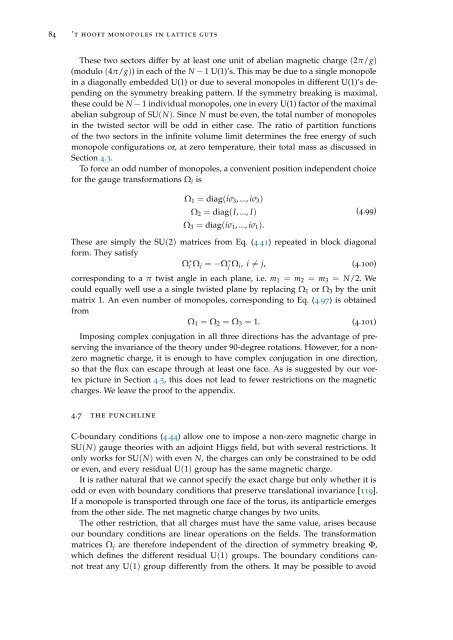Topology, symmetry, and phase transitions in lattice gauge ... - tuprints
Topology, symmetry, and phase transitions in lattice gauge ... - tuprints
Topology, symmetry, and phase transitions in lattice gauge ... - tuprints
You also want an ePaper? Increase the reach of your titles
YUMPU automatically turns print PDFs into web optimized ePapers that Google loves.
84 ’t hooft monopoles <strong>in</strong> <strong>lattice</strong> guts<br />
These two sectors differ by at least one unit of abelian magnetic charge (2π/g)<br />
(modulo (4π/g)) <strong>in</strong> each of the N − 1 U(1)’s. This may be due to a s<strong>in</strong>gle monopole<br />
<strong>in</strong> a diagonally embedded U(1) or due to several monopoles <strong>in</strong> different U(1)’s depend<strong>in</strong>g<br />
on the <strong>symmetry</strong> break<strong>in</strong>g pattern. If the <strong>symmetry</strong> break<strong>in</strong>g is maximal,<br />
these could be N − 1 <strong>in</strong>dividual monopoles, one <strong>in</strong> every U(1) factor of the maximal<br />
abelian subgroup of SU(N). S<strong>in</strong>ce N must be even, the total number of monopoles<br />
<strong>in</strong> the twisted sector will be odd <strong>in</strong> either case. The ratio of partition functions<br />
of the two sectors <strong>in</strong> the <strong>in</strong>f<strong>in</strong>ite volume limit determ<strong>in</strong>es the free energy of such<br />
monopole configurations or, at zero temperature, their total mass as discussed <strong>in</strong><br />
Section 4.3.<br />
To force an odd number of monopoles, a convenient position <strong>in</strong>dependent choice<br />
for the <strong>gauge</strong> transformations Ω i is<br />
Ω 1 = diag(iσ 3 , ..., iσ 3 )<br />
Ω 2 = diag(I, ..., I)<br />
Ω 3 = diag(iσ 1 , ..., iσ 1 ).<br />
(4.99)<br />
These are simply the SU(2) matrices from Eq. (4.41) repeated <strong>in</strong> block diagonal<br />
form. They satisfy<br />
Ω ∗ i Ω j = −Ω ∗ j Ω i, i ̸= j, (4.100)<br />
correspond<strong>in</strong>g to a π twist angle <strong>in</strong> each plane, i.e. m 1 = m 2 = m 3 = N/2. We<br />
could equally well use a a s<strong>in</strong>gle twisted plane by replac<strong>in</strong>g Ω 1 or Ω 3 by the unit<br />
matrix 1. An even number of monopoles, correspond<strong>in</strong>g to Eq. (4.97) is obta<strong>in</strong>ed<br />
from<br />
Ω 1 = Ω 2 = Ω 3 = 1. (4.101)<br />
Impos<strong>in</strong>g complex conjugation <strong>in</strong> all three directions has the advantage of preserv<strong>in</strong>g<br />
the <strong>in</strong>variance of the theory under 90-degree rotations. However, for a nonzero<br />
magnetic charge, it is enough to have complex conjugation <strong>in</strong> one direction,<br />
so that the flux can escape through at least one face. As is suggested by our vortex<br />
picture <strong>in</strong> Section 4.5, this does not lead to fewer restrictions on the magnetic<br />
charges. We leave the proof to the appendix.<br />
4.7 the punchl<strong>in</strong>e<br />
C-boundary conditions (4.44) allow one to impose a non-zero magnetic charge <strong>in</strong><br />
SU(N) <strong>gauge</strong> theories with an adjo<strong>in</strong>t Higgs field, but with several restrictions. It<br />
only works for SU(N) with even N, the charges can only be constra<strong>in</strong>ed to be odd<br />
or even, <strong>and</strong> every residual U(1) group has the same magnetic charge.<br />
It is rather natural that we cannot specify the exact charge but only whether it is<br />
odd or even with boundary conditions that preserve translational <strong>in</strong>variance [119].<br />
If a monopole is transported through one face of the torus, its antiparticle emerges<br />
from the other side. The net magnetic charge changes by two units.<br />
The other restriction, that all charges must have the same value, arises because<br />
our boundary conditions are l<strong>in</strong>ear operations on the fields. The transformation<br />
matrices Ω j are therefore <strong>in</strong>dependent of the direction of <strong>symmetry</strong> break<strong>in</strong>g Φ,<br />
which def<strong>in</strong>es the different residual U(1) groups. The boundary conditions cannot<br />
treat any U(1) group differently from the others. It may be possible to avoid
















